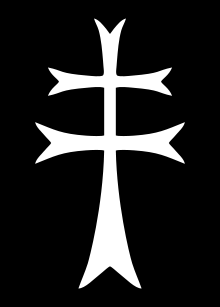- Order of the Holy Ghost
-
- Not to be confused with the Order of the Holy Spirit or the Congregation of the Holy Ghost
- "Hospital of the Holy Ghost" redirects here. For the Danish institution, see: Hospital of the Holy Ghost, Copenhagen.
The Order of the Holy Ghost was a Roman Catholic religious order, founded by Guy de Montpellier in Provence for the care of the sick by groups of lay people. The order was officially established by Pope Innocent III (ca. 1161–June 16, 1216) in the Santo Spirito in Sassia in Rome.
The order was responsible for running hospitals - Hospitals of the Holy Ghost - throughout Europe for centuries, and in its heyday the number of its houses ran into many hundreds. The wealth of its endowments made it a repeated target for the unscrupulous, and the lay Knights of the Holy Ghost, formed on analogy to the major military orders but without their military function, repeatedly attempted to divert its assets to their own use. Several popes made efforts to protect the order as a purely religious body, but Pope Pius V in 1619 re-created the Knights and again diverted the Order's assets into their hands. In 1692 Louis XIV reapplied the property in the possession of the Knights for the benefit of his own Order of Our Lady of Carmel, in effect a pension fund for his own retired soldiers. The remaining religious members of the order were successful in obtaining an edict in 1700 which again confirmed the purely religious nature of the order and regaining the use of the funds for religious and charitable purposes.[1]
These now focused on a single institution, the original and by this time extremely large Arcispedale di Santo Spirito in Sassia, the buildings of which dated from the time of Pope Sixtus IV (1471-84), which at its height was capable of accommodating over 1,000 patients, with additional spaces for contagious and for dangerously insane cases, and more than 100 medical staff, and an international remit. Over time it became a municipal hospital for the inhabitants of Rome, and is now a museum and conference centre. The Order in Rome gradually merged into the medical profession, though offshoots of the order in France survived into the 20th century.
Sources
- ^ Orders of the Holy Ghost - Catholic Encyclopedia article

This article about a Christian organization is a stub. You can help Wikipedia by expanding it.


